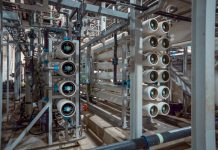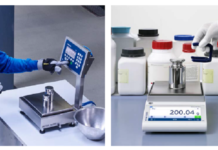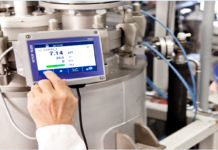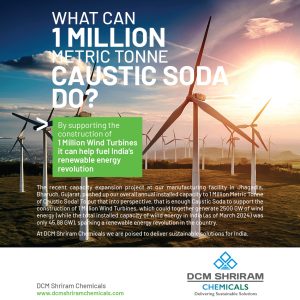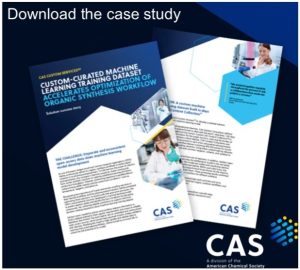January 2024
- Sustainable Business Models for Chemical Producers
- Abstract – The article explores sustainable business models for chemical producers, emphasizing decarbonization strategies, innovation through digitalization, and the pivotal role of partnerships. It highlights initiatives such as resource efficiency, carbon capture, and circularity while showcasing digital solutions’ transformative potential in achieving net-zero goals
- Author – Dr. Anahita Khanlari, Ron Beck
2. The Transformative Power of Integrated Asset Models in Energy and Chemical Industries
- Abstract – The article highlights the significance of Integrated Asset Models (IAM) in the energy and chemical industries, offering a holistic approach for efficient asset management, production optimization, and achieving sustainability goals.
- Author – Tushar Kamerkar, Jagadesh Donepudi, Michelle Wicmandy
3. Transformative Impact of Green and Continuous Chemistry
- Abstract The article talks about unlocking sustainability and embracing green and continuous chemistry in the Indian chemical industry. From reduced carbon footprints to seamless scalability, a synergistic approach accelerates transformative change, fostering innovation and sustainability.
- Author – Anurag Roy
4. Status of Indian Agrochemical Industry
- Abstract – The Indian agrochemical industry is thriving, ranking fourth globally, with a remarkable 9% growth and exports exceeding $5 billion. With a projected market value of $12.58 billion by 2028, India’s agrochemical sector is poised for substantial expansion. Government support, technological advancements, and a strategic focus on innovation contribute to this growth
- Author – Dr. Bipul Saha, Dr. Priyanka R. Sakhare
5. Importance of Innovation for Chemical Industry
- Abstract – Innovation drives success in the chemical industry. Focus on R&D, sustainability, and safety ensures a competitive edge, profitability, and a sustainable future.
- Author – Shernaz Vakil
4. Innovation in the Chemical Industry
- Abstract – The writing celebrates India’s chemical industry evolution, advocating for increased R&D investment to spur innovation, emphasizing growth, adaptability, and future potential in specialty and agrochemicals.
- Author – Nadir Godrej
5. Industrial Cybersecurity Market Trends and Developments
- Abstract – The article explores the evolving challenges and developments in industrial cybersecurity, emphasizing the chemical sector’s vulnerabilities and the need for integrated risk management, program oversight, and advanced technologies. It covers regional trends, regulatory shifts, market evolution, and emerging product trends to
guide users and suppliers in maintaining cyber resilience. The conclusion emphasizes the importance of staying informed to make informed decisions in the ever-changing landscape of industrial cybersecurity. - Author – Sid Snitkin
February 2024
- Harnessing AI for Enhanced Risk Management in the Chemical and Process Industry
- Abstract – Find a better way to do it’. This advice from Thomas Edison is perfect for the chemical and process industries, a field where safety is crucial. The industry is all about mixing and processing chemicals, which can be risky. So, finding better ways to keep things safe is vital. Let’s talk about something that’s really changing how we handle safety: using smart technology, or as some might call it, Artificial Intelligence (AI). This isn’t just about using fancier gadgets. It’s like having a really smart helper who can guess problems before they happen and suggest ways to avoid them. The chemical world can be dangerous – we’re dealing with materials that can be toxic, flammable, explosive, carcinogenic etc. We need to be really careful. Artificial Intelligence (AI) gives us new ways to handle such materials. It can predict problems, keep an eye on things in real time, control robots that do the risky jobs, and make the whole process smarter and safer. Here we cover how AI is making things safer in the chemical industry. We’ll explore the latest tools, see them in action, and think about how they change the way we work. Just like Edison always looked for better ways to do things, we’re exploring how Artificial intelligence can make the chemical industry not only safer but also better at what it does.
- Author – Dr. Ashish Mulraj Ved
2. Chlor-Alkali Operational Digital Twin and Reinforcement Learning Agent for Energy Optimization
- Abstract – Chlor-alkali industries seek AI-driven solutions for energy efficiency and sustainability. Integration of AI with process data enables predictive models and optimization, promising substantial reductions in energy consumption and carbon footprint.
- Author – Rohit Kochar
3. Achieving Process Optimization in Chemical Industry Using Modern Innovative Level Measurement Technologies
- Abstract – Chemical industry applications are, many times, incredibly challenging for level measurement technology because of complex processes, high temperature, pressure, corrosive or erosive materials and even complex design of vessels like blenders, reactors etc. Reliable and accurate level measurement is of paramount significance to achieve maximum process optimization in chemical pndustry. This article explains how modern level measurement Instruments perform accurately and reliably thereby helping to optimize various processes in chemical industry, which will, increase through put and /or efficiency of chemical plants. Few of the typical applications are
discussed to highlight how the enhanced functionality provided by the latest generation of level measurement instrumentation can benefit chemical industry. It also provides vital insights how latest level measurement technology is delivering increased safety, consistency, reliability that all finally lead to process optimization, which turn, helps to reduce costs and improves product quality. - Author – Sumant Juvekar
3. Indian Fertilizer Growth Perspectives, 2024
- Abstract – India’s fertilizer industry has transformed, ensuring food security for over half a century. Despite challenges like geopolitical tensions and climate change, innovations and policy support drive sustainable agricultural growth.
- Author – Dr. MP Sukumaran Nair
4. Some Electrical Problems and How They Were Solved
- Abstract – These are problems that the author encountered in his nearly 45 years experience of working in steel plants to fertilizers and refineries, both in India and abroad. The author and his team resolved these problems through many ingenious and innovative ideas. The problems and the successful solutions, how he went about it are
described herein. Here just a few of the electrical problems encountered and author’s solutions are described. - Author – S Raghava Chari
March 2024
- Beyond Chemistry: The Art and Science of Specialty Chemical Innovation
- Abstract – India’s chemical industry thrives on innovation beyond technology, embracing sustainability, custom synthesis, and skill development to navigate global trends for future growth.
- Author – Gopal Agrawal
2. Biomanufacturing: Pioneering Sustainability Through Biotransformation
- Abstract – The article explores the transformation of the ethanol industry towards sustainability through biotransformation, biomanufacturing, and renewable chemicals, highlighting the role of biorefineries in shaping a greener future.
- Author – Dr. Pramod Kumbhar
3. Trends in Advanced Process Control and OptimisationOptimisation
- Abstract – The article explores the evolving landscape of Advanced Process Control (APC) and optimization technologies in the context of sustainability, digitalization, and operational efficiency. It highlights trends, challenges, and opportunities in deploying APC solutions while emphasizing the crucial role of AI and machine learning
- Author – Peter Reynolds
4. AI Technology Impact on Improving Process Efficiency in the Chemical Industry
- Abstract – Chemical industries embrace AI for process efficiency. From data-driven insights to AI-powered optimization, digital transformation enhances competitiveness and sustainability.
- Author – Rohit Kochar
April 2024
- Technological Advancements in Integrated Recovery of Marine Chemicals from Brines and Desalinationof Marine Chemicals from Brines and Desalination Plant Rejects: A Sustainable ApproachPlant Rejects: A Sustainable Approach
- Abstract – This article delves into the innovative endeavours initiated by CSIR-Central Salt & Marine Chemicals Research Institute (CSIR-CSMCRI) in India to formulate an integrated process for the retrieval of marine salts and bromine from brines and desalination plant rejects. Leveraging cutting-edge techniques such as zero liquid discharge (ZLD) technology, CSIR-CSMCRI aims to optimize resource utilization while
mitigating environmental impact. The significance of innovative strategies in harnessing marine chemical resources in a sustainable and economically feasible manner is underscored in this article. Through collaborative endeavours among academia, industry, and government entities, advancements in marine chemical recovery technologies can usher in a more resilient and environmentally conscious chemical industry. - Author – Dr. Arvind Kumar, Dr. Sumesh Chandra Upadhyay, Dr. Alok Ranjan Paital, Dr. Sumit B. Kamble, Dr. Parul Sahu, Dr. Rahul J Sanghavi
2. Marine Chemicals Recovery from Bittern and Value Addition to by Products from Saltand Value Addition to by Products from Salt IndustryIndustry
- Abstract – The mythological story of “Churning of Ocean”has been mentioned in ShrimadBhagwat.This mythological story symbolically reflects on the abundant source of wealth, which can be derived from the ocean, only if we master the art and science of i.e., extraction of these valuables from sea water as well as the ocean beds.
The sea is about four billion years old.The sea, land, human beings are all living organisms and are linked in a bond of interdependence. Nearly 71% of earth’s surface is covered by oceans. Our country has approx. 2.3 million square kilometre of ocean in our exclusive economic zone (EEZ) and a coastal line of about 7,500 km for an optimum utilization of the sustainable marine resources available in the oceanic region thus offering a vast potential for development of sea-based technologies. Salt is produced from saline water including sea water by evaporation. Sea water is an inexhaustible
storehouse for many chemicals with Salt (NaCl) being a major constituent. Salt, apart from its use for human and animal consumption, is a basic raw material for heavy inorganic chemicals like alkali. The article deals with the present status of the marine chemicals industry. - Author – Dr. J.R. Chunawala
3. Ultra Performance Liquid Chromatography: A Review
- Abstract – Ultra Performance Liquid Chromatography (UPLC) is a cutting-edge method that has opened up new avenues for liquid chromatography. UPLC improves in three areas: “speed, resolution, and sensitivity.” Compared to high-performance liquid chromatography (HPLC), ultra-performance liquid chromatography (UPLC) offers superior resolution, speed, and sensitivity for particles smaller than 2μm. The pharmaceutical industry in the 21st century is looking for new ways to reduce costs and speed up drug development. Meanwhile, UPLC analysis improves the quality of their products, and analytical laboratories are no exception to this trend. In contrast to HPLC, it has been discovered that high pressure has no detrimental effects on the analytical column. Additionally, UPLC uses less time and solvent overall.
- Author – Dr. Shreerang Joshi, Ankita A. Kanhere, Sai Srinivas Ponugoti
4. AI Technology’s Impact on Asset Integrity will be a Game Changer for Industries across Domains
- Abstract – This article discusses the integration of AI and IoT in manufacturing for predictive maintenance and asset management, aimed at enhancing equipment reliability and operational efficiency.
- Author – Rohit Kochar
5. How to Make Pumps More Reliable
- Abstract – The article discusses the intricacies of pump reliability, emphasizing factors like durability, quality over time, maintenance, and technological advancements for improved performance and safety
- Author – S. L. Abhyankar
May 2024
- Renewables to Chemicals – The Future of EPC in Sustainability
- Abstract – The chemical industry is transforming towards sustainability by integrating renewable energy and bio-based chemicals, supported by technological innovations, government policies, and international collaborations to reduce carbon emissions.
- Author – AK Tyagi
2. Enhancing Effectiveness of Project Execution Practices with Progressive Digital Technology
- Abstract – In large scale projects, EPC/EPCM and hybrid project execution modes play a vital role. This article is a comparative study of the EPC/EPCM modes of project execution and highlights the application of integrated digital technology. Digital technology implementation has revolutionised traditional EPC/EPCM processes, with built-in intelligence enabling faster, timely, quality deliveries. We have briefly discussed the most widely utilized digital applications including integrated project planning and management software (PMS), building information management, digital twins, IOT, and IIOT for enhanced asset performance and futuristic feature predictions for further enhancement in industrial project execution.
- Author – D S Latha, Bharat Balkrishna Gharat, Sunil P Agarwal, Sunil L Choudhari
3. Expanding Horizons: EPC’s Role in Driving Transformation in the Chemical Sector
- Abstract – India’s EPC firms are key in advancing infrastructure and expanding into the chemical sector, emphasizing regulatory compliance, safety, sustainability, and innovative solutions to support the industry’s growth and environmental goals.
- Author – Rajiv Menon
4. Selecting it Right: Foundation of Successful EPC Project
- Abstract – One of the key aspects for a successful EPC project in oil and gas industry, is selecting optimal configuration of a refinery or petrochemical complex. The correct site selection is of utmost importance with strategic, economic as well as operating considerations. Selection of the right technology is also an important factor. Over the years, it has been seen that these selections need thorough analysis using scientific tools. The selection criteria for configuration, site and technology need to be based on multiple factors. Further, it is also essential that selection should be qualified in a manner that it aligns with investors as well as organization goals. The configuration selection uses tools like linear programming and economic analysis, which helps in
choosing the optimum pathway. On the other hand, technology selection will be by excel based tools for establishing techno-commercial comparison. Site selection will depend upon strategic and geo-political factors along with other factors such as ease of operation and economics. - Author – Parveen Kalia, Srinivasa Oruganti
5. Navigating the Perilous Waters: Averting the Ten Biggest Pitfalls of Oil/Chemical EPC Projects
- Abstract – Engineering, Procurement, and Construction (EPC) projects are complex endeavours that require meticulous planning, robust management, and effective communication. However, even the most experienced teams can fall prey to costly pitfalls that jeopardize project success. The paper identifies ten critical errors that can lead to significant financial losses and project delays. The article delves into each pitfall, offering insights into their implications and providing recommendations for avoidance and mitigation, aiming to guide practitioners towards more successful project outcomes.
- Author – Ayan Dasgupta, Arun Munjal
June 2024
- Transitioning Towards Sustainability: Journey of the Chemical Sector Toward Decarbonization Using Alternative ResourcesSector Toward Decarbonization Using Alternative Resources
- Abstract – The chemical industry is currently at the point of needing to reduce its carbon footprint to meet its sustainable goals. The article examines how this sector is moving to more ecologically friendly resources, driven by the pursuit of lessening environmental harm, increasing energy efficiency, and more vigorously addressing climate change. The article investigates using biomass, waste gases CO2, and other feedstocks, emphasizing the tremendous growth in industry and recognizing the technical and economic challenges of adopting them. The article investigates market trends, technological advances, and the investment implications of making the change to cleaner resources. This analysis shows how the chemical industry can reduce its carbon emissions by a great deal and stimulate innovation within a circular economic model. However, the problem is whether this shift will be obstructed in such areas as ensuring a supply of resources, advancing conversion technologies, or integrating new materials into established systems. The paper underscores the need for policy offers such as forming alliances among policymakers, industry stakeholders and scientists investing in research and development initiatives and creating supportive regulatory frameworks. This joint effort will build efficiency and a more robust chemical industry to adhere to global climate goals and create a zero-carbon future.
- Author – Ayan Dasgupta
2. Empowering the Hydrogen Economy in Chemical Industries: India’s Green Hydrogen Mission and Global Energy TransitionIndia’s Green Hydrogen Mission and Global Energy Transition
- Abstract – Hydrogen emerges as a pivotal energy carrier in global decarbonization efforts across sectors, fuelled by its zero-emission potential and declining production costs. Its role as a fossil fuel alternative drives the shift towards a hydrogen economy, particularly in emissions-intensive sectors like steel and transportation, underscoring its importance in fostering sustainability. But not all sources of hydrogen production are carbon neutral which brings our attention to green hydrogen and blue hydrogen (followed by CO2 sequestration). India’s renewable energy abundance positions it as a potential leader in green hydrogen production, supported by initiatives like the national green hydrogen mission targeting five million metric tons annually by 2030. Embracing hydrogen is pivotal for decarbonizing the chemical industry, offering a pathway to cleaner manufacturing processes and economic resilience through localized production. This synergy between hydrogen advancements, industry decarbonization, and global energy transitions signifies a transformative era in sustainable development.
- Author – Priyabrata Mohapatra, Ujjwal Tripathi
3. Walking the Tightrope: Striking a Balance Between Environmental Goals, Economic Realities is a Key for Sustainable Chemistry
- Abstract – Chemicals are vital to modern life, yet sustainability is crucial. Green chemistry, circular economy, and collaborative initiatives can balance environmental care with economic feasibility for a sustainable future.
- Author – Dr. Kamlesh Fondekar
4. Harnessing Lignin as a Sustainable Raw Material for Polyurethane ProductionPolyurethane Production
- Abstract – Polyurethane (PU) is a versatile polymer used extensively in various industries. Derived traditionally from fossil fuels, PUs can now incorporate lignin, a renewable biomass resource, enhancing sustainability while maintaining desirable properties such as biodegradability, flame retardancy, and mechanical strength
- Author – Professor G. D. Yadav
5. From Protection to Diffusion: Intellectual Property as a Tool for Transitioning to a Low-Carbon Economy
- Abstract – In pursuit of the Sustainable Development Goals by 2030, both public and private firms globally are innovating new technologies and business models to mitigate the environmental impact of conventional practices. These innovations yield valuable intellectual property (IP), including patents, trademarks (as formal IP assets), and know how and databases (as informal IP assets). Traditionally seen as protective tools, IP now serves as a catalyst for sustainability across industries. From industry to societal levels, responsible IP management practices are enabling firms to enhance their sustainability impact while maintaining control over access and use of IP-protected innovations. The article explores how firms in the chemical industry are leveraging IP strategies to drive the diffusion and adoption of sustainable innovations while safeguarding their brands.
- Author – Dr. Akriti Jain
6. Unlocking the Potential: The Role of Carbon Credits and Circular Economy in Climate ActionCircular Economy in Climate Action
- Abstract – In the global fight against climate change, carbon markets and the circular economy stand as pivotal strategies for driving sustainability and reducing emissions. From their inception as innovative concepts to their current status as indispensable mechanisms for environmental progress, carbon credits and circular economy principles have evolved into key pillars of global sustainability efforts. This article delves into the transformative influence of carbon markets and the circular economy in addressing climate change and fostering sustainability. It traces the evolution of carbon markets, originating from pioneering initiatives, such as the SO2 allowance trading program of North America and the European Union Emissions Trading Scheme. It explains the concept of carbon credits and their pivotal role in facilitating emissions reductions through initiatives that mitigate, remove or prevent greenhouse gas emissions.
Additionally, the article scrutinizes the holistic approach of the circular economy to resource management, accentuating principles of reuse, recycling and regeneration. It underscores the vital role of the chemical industry in propelling sustainability through innovations in production processes and product lifecycles. Overall, the article emphasizes the interconnectedness of carbon markets, the circular economy and the chemical industry in driving climate action and sustainability. By harnessing the power of markets, innovation and collaboration, we can accelerate the transition towards a low-carbon, circular economy, fostering a more sustainable and resilient planet for current and future generations. - Author – Manish Dabkara
7. Microalgae for Effluent Treatment – An Opportunity
- Abstract – There are sustainable microalgae-based wastewater treatment solutions that reduce carbon emissions and generate valuable co-products. This technology leverages natural photosynthesis to treat effluents efficiently, producing clean water and high-value algal biomass for diverse commercial applications.
- Author – Dr. Ninad Gujarathi
8. How Advances in Catalysis Enable Green Chemistry?
- Abstract – In chemicals manufacturing, green chemistry is the buzz word. In this article how the practice of catalysis enables all the arms of green chemistry, namely the E-factor, atom economy, yield and waste reduction, is explained. A brief introduction is given to the new concept of photon assisted catalysis in the context of green chemistry.
- Author – B. Viswanathan
July 2024
- Improve Success Rate in R&D
- Abstract – In the modern digital age, both advanced and basic products are integral to daily life, with their development relying heavily on chemical R&D. This article explores how chemical R&D has evolved from focusing on breakthrough innovations, such as Nylon, to addressing performance enhancement, new applications, and disruptive ideas. Success in chemical R&D is defined through time to market, return on investment, and value creation.
- Author – Vishal Sharma, Dr. Raja Kaliappan
2. New Process Developments for the Synthesis of Pyridine-Based Heterocycles
- Abstract – This article explores the synthesis of diverse heterocycles utilising commercially and readily available pyridine and its derivatives. New methods have been developed for the synthesis of various heterocycles, including imidazo[1,2-a]pyrazines, imidazo[1, 5-a]pyridines, indolizines, imidazo[2,1-a]isoquinolines, pyrazolo[1, 5-a]
pyridines, sulfenylated imidazopyridines, indolizines, thiazolo[3,4-a]pyridin-3-imines, pyrido[1,2-a]indoles, benzo[f]pyrido[1,2-a]indoles, 1,5-naphthyridines, 1,8-naphthyridines, and 2,6-disubstituted pyridines. In each class of molecules, representative table of contents are provided with the literature citation and brief
conditions employed for their synthesis. Most of the methods described for the synthesis of pyridine-fused heterocycles are under metal-free conditions and in some cases, wherever required, the readily available transition metal catalysts or non-transition metals were employed. All the synthesized heterocycles were prepared at the lab scale for publication; however, we also demonstrated the applicability of some of the molecules at the gram scale under the same optimized conditions for commercial interest. - Author – Dr. S. Adimurthy
3. Harnessing Sonochemistry with Ultrasonic Reactors: Revolutionizing Chemical Processes
- Abstract – The article explores the transformative role of ultrasonic reactors in sonochemistry, accelerating reactions, enabling diverse applications, and addressing challenges for sustainable chemical innovation.
- Author – Lalit Vashista
4. Approach for Qualifying Carbon Steel Piping Systems for NegativeTemperature Applications during Depressurization
- Abstract – The carbon steel piping system is qualified to operate effectively under low-temperature conditions during gas depressurization, particularly when the gas temperature drops below the inversion temperature, resulting in cooling due to the Joule –Thompson effect. The ASME B31.3 and ASME B31T codes specify the requirements for qualifying carbon steel piping systems to operate in negative temperature zones, consid-
ering factors such as thickness, P –T rating, and stress ratio. However, they do not offer a comprehensive method for qualifying valves within these piping systems.The piping stress analysis software considers standard P –T rated valves as rigid elements and assigns zero stress at valve nodes. To ascertain the stress ratio of the valve, an analytical approach is employed to assess the generated stress at neighbouring nodes of the valve, thereby calculating the stress ratio. This process ensures that the stress ratio complies with the prescribed code limits for defined negative temperatures. - Author – Mrinmoy Ghosh Choudhury, Vivek Kumar Tiwari
5. Efficient Filtration for Reliable Production and High Quality
- Abstract – Numerous processes in the chemical industry are inconceivable without filtration and separation. After all, the removal of unwanted particles not only determines the quality of products, but also ensures the necessary safety.
- Author – Marius Schaub
August 2024
- Advances in Fluid Catalytic Cracking. Its Emerging and Evolving Role
- Abstract – Fluid Catalytic Cracking (FCC) units are evolving to address the crude oil refining industry’s challenges, including declining transportation fuel demand and increased petrochemical market opportunities. Advances in FCC technologies enable refiners to produce higher-value petrochemical intermediates, enhancing competitiveness and profitability.
- Author – Dr. Marcio Wagner
2. Challenges in Processing of Sulfur Dioxide in the Claus Plant
- Abstract – The classical feedgas streams of a Sulfur Recovery Unit (SRU) would be from the Amine Regeneration and the Sour Water Stripping unit and would contain varying amounts of H2 S as the sulfur source. This paper investigates the unique scenario of a Claus plant when the feedgas cocktail may also include some amounts of SO2 , as typically recovered from a regenerable flue gas desulphurization unit. The presence of SO2 induces a ‘quenching’ effect on the Claus furnace temperature, as each mole of SO 2 replaces 1.5 moles of O 2 required in the furnace. The loss of exotherm in the Claus furnace in turn presents challenges in meeting the necessary temperature required for NH 3 destruction. The extent of quenching experienced in the Claus furnace with varying amounts of SO2 in the Claus feedgas stream is studied. The potential remedial measures that may be applied, namely feed preheat, fuel gas cofiring, oxygen enrichment, two-zone furnace design, are also explored. A comparative assessment of options is presented, siting the advantages and limitations of each of the processes, providing generic guidelines on the ‘best possible’ path forward for the unique scenario when SRU needs to co-process SO2 gas stream along with its standard feedstocks.
- Author – Debopam Chaudhuri, Michiel Baerends
3. Digital Twins and AI-powered Tools Reshape the Future of Refinery Management
- Abstract – India’s oil and gas sector is undergoing a digital transformation through process digital twin technology, aiming to boost efficiency and profitability. By leveraging advanced analytics and AI, refineries can optimize operations, reduce costs, and improve decision-making, positioning themselves for future growth.
- Author – Michelle Wicmandy, Soni Malik
4. Newer Specialty Chemicals and Advances in Process Automation Driving Efficiency in Oil and Gas Industries
- Abstract – Advancements in process automation and specialty chemicals are revolutionizing India’s oil and gas industry, enhancing efficiency, sustainability, and regulatory compliance. The “Make in India” initiative fuels domestic innovation and growth.
- Author – Sajiv Ravindran Nath
5. Safety in Storage of Petrochemicals
- Abstract – Oil remains the dominant global energy source, necessitating extensive transportation and storage infrastructure. Proper storage of oil is crucial, especially for maintaining strategic reserves to ensure supply during crises. Traditional storage methods involve surface tanks and tank farms, which serve as buffers for oil transport. However, there is a growing shift toward underground storage in salt caverns, offering enhanced safety and reduced environmental risks.
- Author – V. Raju
September 2024
- Alternative Fuels in Energy Transition Landscape
- Abstract – Growing emphasis on introducing renewable energy in the energy mix of the industries to decarbonise the operations is driving the need for looking for alternate green fuels like hydrogen and ammonia. Original Equipment Manufacturers of gas turbines and pulverised coal fired boilers are investing in R&D to explore the extent of usage of alternative green fuels and do away with fossil fuels. Technologies using green fuels would serve as energy storage options which can be considered as a viable alternative for battery energy storage systems conventionally used in renewable energy. This paper describes the technical aspects in utilising these fuels as retrofits in gas
turbines / pulverised coal fired boilers in the immediate future and also highlights the challenges for its 100% usage. - Author – Lakshmana Rao Vadlamani, Nanda Kishore Desapande
2. Energy Transitions: From Fossil Fuels to Greener and Cleaner Alternatives
- Abstract – This article explores India’s transition from fossil fuels to renewable energy, highlighting the role of the chemical sector, government initiatives, and innovations crucial for achieving sustainability goals.
- Author – S Sunil Kumar
3. Hydrogen Hubs – Materializing Indian Aspirations
- Abstract – The article explores the transition to hydrogen as a sustainable fuel, detailing its production, infrastructure, and global initiatives, with a focus on India’s potential to become a major green hydrogen hub.
- Author – MP Sukumaran Nair
4. Use of Sea Water in Cooling Tower Operation in Refinery Application
- Abstract – Making sea water cooling tower operation reliable is plausibly tenable. This is based on best practices derived from hands on learning on the job. It goes without saying that if a pump is the heart of any process plant, then cooling media plays the crucial role of regulation of energy and temperature profile so that desired yields are produced.
- Author – Sourav Kumar Chatterjee
5. Pipeline Impedance Heating Systems
- Abstract – Impedance pipe heating systems utilize the pipe itself as a heating element by applying low-voltage AC, generating heat through electrical resistance. This method ensures uniform heating, reduces maintenance, and eliminates the need for additional equipment.
- Author – S. Raghava Chari
October 2024
- Transforming the Indian Fertilizer Industry: Key Challenges, Recent Initiatives and Future Policy Directions
- Abstract – The article discusses the challenges and recent initiatives in India’s fertilizer industry, emphasizing the need for policy reforms to enhance sustainability, efficiency, and self-reliance in urea production while addressing issues like subsidy structure, nutrient balance and environmental impact
- Author – R G Rajan
2. Progress of Decarbonization in Ammonia Plants
- Abstract – The article discusses the global shift toward decarbonizing ammonia production, highlighting the use of carbon capture and storage (CCS), renewable energy, and green hydrogen technologies. It emphasizes innovations in the ammonia industry and the need for policy support to achieve net-zero goals by 2050.
- Author – Dr MP Sukumaran Nair
3. Improved Steam Reforming Catalysts for Energy Saving and Enhanced Production
- Abstract – New steam reforming catalysts, like the ReforMax LDP Plus series, enhance syngas production efficiency by reducing pressure drop, improving heat transfer, and enabling energy savings and increased output in industrial applications.
- Author – Gagandeep Samad, Stefan Gebert
4. Innovation in Biofertilizers: Boosting Soil Fertility Naturally
- Abstract – The article explores the rising importance of biofertilizers in sustainable agriculture, highlighting their role in enhancing soil fertility and plant health while reducing reliance on chemical fertilizers. It emphasizes market trends, innovations, and the long-term benefits of adopting eco-friendly farming practices
- Author – Harshvardhan Bhagchandka
5. Safe and Sustainable Innovations Are the Future of the Indian Agrochemical Industry
- Abstract – The article explores the challenges and growth potential of India’s agrochemical industry, highlighting the need for innovation, sustainable practices, and increased investment to enhance productivity and global competitiveness.
- Author – Vimal Kumar Alawadhi
November 2024
- Technological Innovations and Global Market Dynamics in the Chemical Industry
- Abstract – Technological innovations like AI, blockchain, and IoT are revolutionizing the chemical industry, enhancing efficiency, transparency, and competitiveness amid dynamic global market shifts and emerging demands.
- Author – Jay Lakhani
2. The Market and Footprints of Colorants Across Different Industries
- Abstract – The global colorant market is evolving, driven by sustainability, innovation, and regulation. Key industries like textiles, food, and automotive are transitioning to eco-friendly and high-performance colorants, balancing environmental impact with performance demands across diverse applications.
- Author – Tanushri Gajanan Saundarkar, Shriya Verma, Disha Tripathi
3. Mathematics of Pumping
- Abstract – The paper explores the mathematics of pumps, focusing on reciprocating piston and centrifugal pumps. It covers key concepts like flow per revolution, total head, Affinity Laws, specific speed, power, efficiency, and cavitation, providing insights into pump performance and optimization.
- Author – S. L. Abhyankar
4. Water Recycling and Role of Technology
- Abstract – Water recycling is a crucial strategy for promoting sustainability by reusing wastewater and reducing freshwater dependence. It supports water security, food security, and environmental sustainability, addressing challenges like contamination risks and requiring technological, policy, and financial collaboration.
- Author – Raju
5. Koyambedu TTRO Plant: Revolutionizing Water Reuse
- Abstract – The Koyambedu TTRO Plant in Chennai uses advanced water reuse technologies to treat 45 million liters of wastewater daily, providing a sustainable water source for industries and reducing pressure on freshwater resources, offering a model for urban water conservation
- Author – Rohan Mittal
December 2024
- Rethinking the Accident Pyramid: A Shift Towards Proactive Integrated Safety Indicators for High Hazard Chemical Industries
- Abstract – The traditional safety pyramid, based on Heinrich’s theory, and API 754 guidelines for process safety indicators are widely used frameworks for assessing safety performance in high-hazard industries. However, their lack of integration often leads to inefficiencies and missed opportunities for proactive risk management. The article proposes a reimagined, integrated safety pyramid that combines personnel safety and process safety indicators into a unified six-tier approach to improve safety performance in high-hazard industries such as petrochemical and refining
- Author – Anshulkumar Tiwari
2. Functional Safety (SIL) – Do We Really Understand the Lifecycle?
- Abstract – Functional Safety (popularly called as ‘SIL’) is not something new in the industry. It is a very commonly heard term and in layman’s language, “It is Safety in the Instrumentation industry.” The article is written based on the personal experience of the author while conducting various Safety Integrity Level (SIL) studies in the process industry and is meant to simplify the lifecycle from a layman’s perspective so as to better understand the requirements of the IEC 61511 standard. The focus is on the lifecycle concept also called as Safety Lifecycle
- Author – Shivendra Kapoor
3. How Accurate is your Safety & Risk Management System?
- Abstract – The chemical industry, a cornerstone of modern society, is inherently fraught with risks due to the hazardous nature of its operations. Traditional Safety Management Systems (SMS) and Risk Management Systems (RMS) often fall short in addressing root causes. This paper introduces the SEPLO Process, a novel approach that integrates four key organizational assets: Basic Technology, Plant Facility, Human Capital, and Organization. By synchronizing these elements, organizations can enhance safety, efficiency, environmental performance, and profitability. The article redefines safety as a strategic asset rather than a cost, showcasing how the SEPLO Process can minimize accidents, boost operational performance, and support long-term sustainability.
- Author – Rajendra Utturkar
4. In-house Root Cause Analysis Leads to Reliability Improvement of Large Steam Boiler
- Abstract – Failure can happen in infinite times in infinite manner in infinite ambiance profile. Only the alert early detection potentially tends to decimate the severity health safety environment hazards, energy profit and growth loss, attrition in confidence of working people leading to poor risk management. The article illustrates how critical assets like large steam boiler operating in petroleum refinery develops defects and how it was tracked and appropriate viable cure was incorporated that eradicated the very failure mode successively
- Author – Sourav Kumar Chatterjee
5. Detect and Prevent Sulfur Tank Fire
- Abstract – The article describes the major causes of fire in a liquid sulfur tank and discusses the conventional approaches implemented in mitigating it, with a special emphasis on a novel approach in reducing the potential of fire in a sulfur tank.
- Author – Debopam Chaudhuri, Jignesh Desai, Ranjit Mondal
6. Prioritizing Maintenance and Reliability: A Clarion Call for Sustainable Growth in India’s Chemical Industry
- Abstract – A call for India’s chemical industry to adopt risk-based maintenance strategies, balancing safety, operational excellence, and sustainability, fostering resilient growth amid global competition and environmental challenges.
- Author – Hitesh Thaker
7. LPG Plant Fire Fighting System Maintenance
- Abstract – Liquefied Petroleum Gas (LPG) is widely used for various applications, including heating, cooking, and as fuel for vehicles. However, the flammable nature of LPG necessitates stringent safety measures, particularly in the design and maintenance of fire fighting systems within LPG plants. Regular maintenance of fire fighting systems ensures readiness in case of emergencies, preventing potential disasters and protecting both personnel and the environment. For these reasons fire fighting equipments maintenance and inspection play important role create safe LPG Facilities
- Author – Onur ÖZUTKU
8. Optimizing Asset Management and Maintenance in Crude Oil Refining Stockpiling Systems
- Abstract – In crude oil refineries, the maintenance and asset management of stockpiling systems, including storage tanks and transfer assets, often receive less priority compared to refining units. This oversight can jeopardize the safety, reliability, and profitability of the refinery. The article explores the importance of maintaining stockpiling assets, outlines key strategies to enhance asset management, and offers solutions for overcoming operational and maintenance challenges
- Author – Dr. Marcio Wagner da Silva









